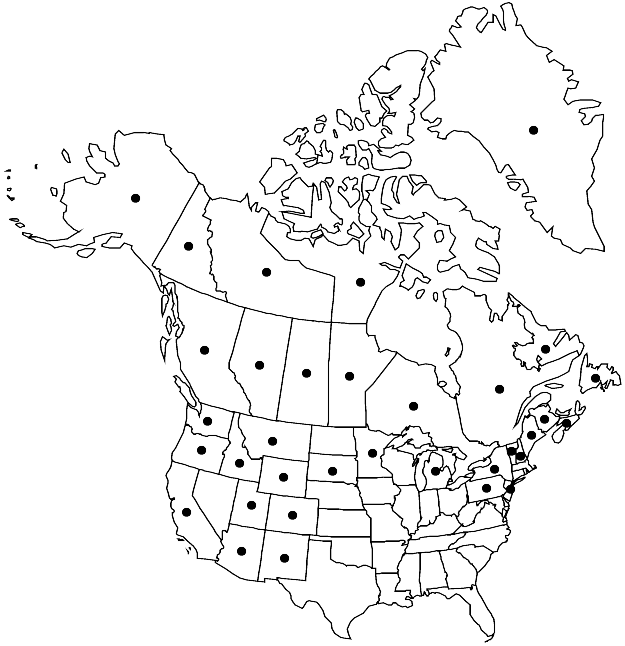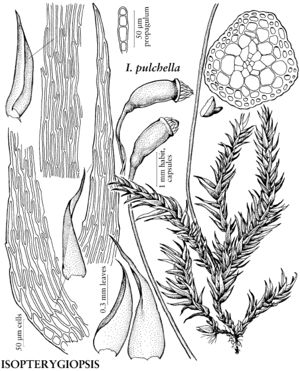Isopterygiopsis pulchella
J. Hattori Bot. Lab. 63: 450. 1987.
Plants in thin to dense mats, light green to yellowish. Stems 2 cm, 1–2 mm wide, not complanate-foliate; epidermal cells somewhat large, exterior walls thinner than interior, cortical cells in 1–several layers, smaller, walls thick. Leaves flaccid, erect-spreading, occasionally secund, close or sometimes distant, lanceolate to slenderly ovate-lanceolate, subconcave, 0.5–1.5 × 0.2–0.4 mm; margins plane to erect throughout, entire or sometimes minutely serrulate at apex, often 1 or 2 cells distinctly serrulate in alar region; apex gradually long-acuminate; alar cells quadrate to short-rectangular only on margins or sometimes not differentiated, 16–31 × 7–9 µm; medial laminal cells 96–156 × 5–7 µm. Specialized asexual reproduction rarely present as propagula, 33–61 × 9–14 µm, of 2–5 cells. Sexual condition autoicous. Seta red to reddish brown, 1–2 cm. Capsule subcernuous to cernuous, rarely erect, yellow to orange-brown, oblong to ovoid, straight to subarcuate, 0.5–2.5 mm; operculum conic to conic-apiculate, 0.2–0.3 mm. Spores 9–14 µm.
Phenology: Capsules mature spring–late summer.
Habitat: Acidic cliff crevices, rocky banks, calcareous soil, soil on overturned tree roots, base of trees, decaying wood
Elevation: low to high elevations (10-2300 m)
Distribution

Greenland, Alta., B.C., Man., N.B., Nfld. and Labr., N.W.T., N.S., Nunavut, Ont., Que., Sask., Yukon, Alaska, Ariz., Calif., Colo., Idaho, Maine, Mich., Minn., Mont., N.H., N.J., N.Mex., N.Y., Oreg., Pa., S.Dak., Utah, Vt., Wash., Wyo., e Mexico, s South America, Europe, Asia, Africa, Pacific Islands (New Zealand).
Discussion
Isopterygiopsis pulchella is autoicous and often produces sporophytes; the other two species of Isopterygiopsis are dioicous and usually sterile. Isopterygiopsis pulchella is further distinguished by erect-spreading, sometimes secund, lanceolate to slenderly ovate-lanceolate, gradually acuminate, nondecurrent leaves with entire or minutely serrulate margins at the apex and base.
The epidermal stem cells of Isopterygiopsis alpicola and I. pulchella are scarcely enlarged, somewhat thin-walled and not as distinctly differentiated from the interior cortical cells as those of I. muelleriana. All three species have papillose rhizoids and clusters of 2–6-celled cylindric or fusiform gemmae in the leaf axils; both characters readily place them in Isopterygiopsis. Orthothecium intricatum (Hartman) Schimper and O. strictum Lorentz may be confused with I. pulchella in the Arctic, but the former two species are dioicous and rarely produce sporophytes. Also, Orthothecium has mostly straight, erect-spreading leaves rather than secund leaves as in I. pulchella. The Utah record is that of S. Flowers (1973). W. A. Weber (pers. comm.) noted that O. diminutivum (Grout) H. A. Crum, Steere & L. E. Anderson (Holmgrenia diminutiva Grout) described from Colorado is synonymous with I. pulchella because of its papillose rhizoids and multicellular, cylindric brood bodies.
Selected References
None.
